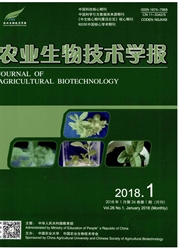

 中文摘要:
中文摘要:
依据中国野生葡萄(Vitis pseudoreticulata)抗黑痘病(Sphaceloma ampelinum)基因RAPD标记OPS03-1354的全长序列,设计合成了两个寡聚核苷酸R1(5'-CAGAGGTCCCTAGCTAAT-3)'和R2(5'-ACA ATCACCCAACTCCTC-3)'作为引物。首先对获得该RAPD标记的种间杂交组合白河-35-1(V.pseudoret-iculata clone Baihe-35-1)×佳利酿(V.vinifera cv.Carignane)亲本及其F251株进行PCR分析,其中寡聚核苷酸R2能在抗黑痘病植株中扩增出约1100bp的DNA片段。进一步用R2对另一种间杂交组合广西-1(V.pseudoreticulata clone Guangxi-1)×京可晶(V.vinifera cv.Jingkejing)F1339株进行PCR检测,R2能在抗病植株中扩增出约1100bp的DNA片段。最后用R2对48份葡萄资源包括中国野生葡萄、美国野生葡萄和欧洲葡萄进行了PCR检测,在抗病株系和品种中也能扩增出这一片段。结果表明,获得的约1100bp特异片段为葡萄抗黑痘病基因的序列特异性扩增区(SCAR)标记,凡扩增出该SCAR标记的植株即是抗黑痘病基因的携带者和抗黑痘病性状的表达者。将该SCAR标记克隆与测序,其实际长度为1110bp,命名为SCS03-1110。获得该SCAR标记的18bp寡聚核苷酸R2(5'-ACAATCACCCAACTCCTC-3)'具有检测葡萄抗黑痘病基因的DNA探针作用。
 英文摘要:
英文摘要:
Based on the sequence of RAPD marker OPS03-1354 linked to anthracnose(Sphaceloma ampelinum) resistance gene,two oligomers,R1(5'-CAGAGGTCCCTAGCTAAT-3') and R2(5'-ACAATCACCCAACTC CTC-3'),were designed and synthesized,and used as special primer for PCR analysis among the parents and 51 F1 individuals from interspecific cross combination Vitis pseudoreticulata Baihe-35-1×V.vinifera Carignane.A DNA band about 1 100 bp could be amplified among resistant plants using primerR2,and was present in resistant plants of 339 F1 individuals from interspecific cross combination Guangxi-1(V.pseudoreticulata)×Jingkejing(V.vinifera) and of 47 lines(varieties) of grape resources,including Chinese wild Vitis,American wild Vitis and European grape,by PCR analysis.The result showed that the DNA band about 1 100 bp was a sequence-characterized amplified region(SCAR) markerlinked to anthracnose-resistance gene in grape.The plants with the SCAR marker were the carrierand expression of anthracnose-resistance gene.Cloning and sequencing of the SCAR marker were carried out.The length of the SCAR marker was actually 1 110 bp and it was named SCS03-1110.This research reveals that the oligomer R2(5'-ACAATCACCCAACTCCTC-3') as a DNA probe can be used to identify anthracnose-resistance gene of grape germplasm resources and hybrids from anthracnose-resistance breeding program by PCR assay.
 同期刊论文项目
同期刊论文项目
 同项目期刊论文
同项目期刊论文
 Agrobacterium -mediated genetic transformation of grapevine ( Vitis vinifera L.) with a novel stilbe
Agrobacterium -mediated genetic transformation of grapevine ( Vitis vinifera L.) with a novel stilbe Breeding of disease-resistant seedless grapes using Chinese wild Vitis spp.: I. In vitro embryo resc
Breeding of disease-resistant seedless grapes using Chinese wild Vitis spp.: I. In vitro embryo resc Molecular cloning and characterization of novel heat shock protein 90 gene from a wild Vitis pseduor
Molecular cloning and characterization of novel heat shock protein 90 gene from a wild Vitis pseduor 期刊信息
期刊信息
